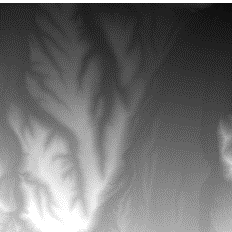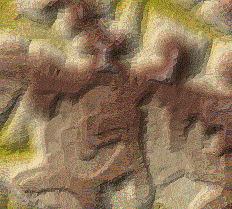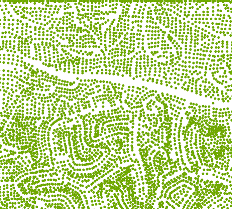Available with 3D Analyst license.
Although triangulated irregular networks (TIN) and terrain datasets are considered vector surfaces, they actually comprise other feature-based information that may be more valuable to you in its native form as points, lines, or polygons. In ArcGIS, you can convert surface data to vector features very easily. Your analytic capabilities may increase through use in selections, overlays, editing, or multilayer modeling.
There are three surfaces you may want to convert to vectors such as points, lines, and polygons. Raster, TIN, and terrain dataset surfaces have three different methods for conversion to vector data.
Raster surfaces to vector features
Elevations contained in raster surfaces would normally be extracted into polygon feature data that could be used with multivariate analysis, site suitability, overlays, or other analytic operations. There are several geoprocessing tools that will assist you in converting your raster surface into vector feature data.
For a complete list of the geoprocessing tools you can use to convert your raster data to vector data, see Converting raster surfaces to features.
Here is an example of using the Raster To Polygon tool to convert a raster DEM into polygons for analysis. The result of this analysis is a categorized polygon feature that could be used with other feature layers.


TIN surfaces to vector features
Converting TINs to features involves fewer steps. You can extract slope and aspect polygons directly from TIN surfaces, or you can extract the elevation values of nodes in the TIN as a point feature class. You can use the slope and polygon features extracted from a TIN just as you would use such features extracted from a raster. You can use several geoprocessing tools to convert TIN features to vector features. These tools can be found in the 3D Analyst toolbox within the Conversion > From TIN toolset.
For a complete list of the geoprocessing tools you can use to convert your TIN surface data to vector data, see Converting TIN surfaces to features.
An example of a TIN converted to a point feature layer is shown here.


Terrain dataset surfaces to vector features
Terrain datasets are unique in that vector feature classes must participate during the creation of the terrain dataset. This means that it is entirely possible that you already have access to point, line, or polygon feature data for your terrain as source data. However, it is possible that multipoint features were actually embedded in the terrain dataset when it was created. You can use the Remove Feature Classes From Terrains tool to extract a multipoint feature class embedded in a terrain dataset.
For other terrain surface-to-vector conversions, the process is similar to TIN-to-vector feature conversion. However, a significant difference is that you need to convert the terrain dataset to a TIN first. The advantage of this is that you can choose any of the terrain dataset pyramids that allow a TIN to be generated without full resolution detail. Performance can be greatly enhanced by following this method because not all nodes in the full resolution will be selected for feature conversion.
For more information about how to convert your terrain surface data to vector data, see Converting terrain surfaces to features.